方波信号波形合成电路
lm358正弦波方波三角波产生电路
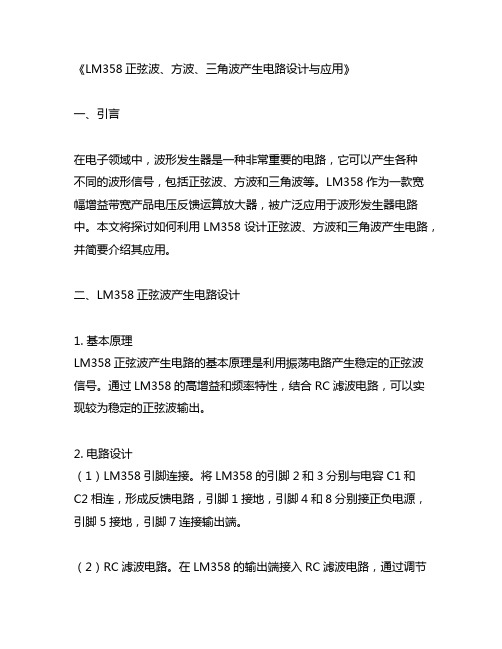
《LM358正弦波、方波、三角波产生电路设计与应用》一、引言在电子领域中,波形发生器是一种非常重要的电路,它可以产生各种不同的波形信号,包括正弦波、方波和三角波等。
LM358作为一款宽幅增益带宽产品电压反馈运算放大器,被广泛应用于波形发生器电路中。
本文将探讨如何利用LM358设计正弦波、方波和三角波产生电路,并简要介绍其应用。
二、LM358正弦波产生电路设计1. 基本原理LM358正弦波产生电路的基本原理是利用振荡电路产生稳定的正弦波信号。
通过LM358的高增益和频率特性,结合RC滤波电路,可以实现较为稳定的正弦波输出。
2. 电路设计(1)LM358引脚连接。
将LM358的引脚2和3分别与电容C1和C2相连,形成反馈电路,引脚1接地,引脚4和8分别接正负电源,引脚5接地,引脚7连接输出端。
(2)RC滤波电路。
在LM358的输出端接入RC滤波电路,通过调节电阻和电容的数值,可以实现所需的正弦波频率和幅值。
3. 电路测试连接电源并接入示波器进行测试,调节RC滤波电路的参数,可以观察到稳定的正弦波信号输出。
三、LM358方波产生电路设计1. 基本原理LM358方波产生电路的基本原理是通过LM358的高增益和高速响应特性,结合反相输入和正向输入,实现对方波信号的产生。
2. 电路设计(1)LM358引脚连接。
将LM358的引脚2和3分别与电阻R1和R2相连,引脚1接地,引脚4和8分别接正负电源,引脚5接地,引脚7连接输出端。
(2)反相输入和正向输入。
通过R1和R2的分压作用,实现LM358反相输入和正向输入,从而产生方波输出。
3. 电路测试连接电源并接入示波器进行测试,调节R1和R2的数值,可以观察到稳定的方波信号输出。
四、LM358三角波产生电路设计1. 基本原理LM358三角波产生电路的基本原理是通过LM358的反相输入和正向输入结合,实现对三角波信号的产生。
2. 电路设计(1)LM358引脚连接。
将LM358的引脚2和3分别与电容C1和C2相连,引脚1接地,引脚4和8分别接正负电源,引脚5接地,引脚7连接输出端。
方波的合成与分解
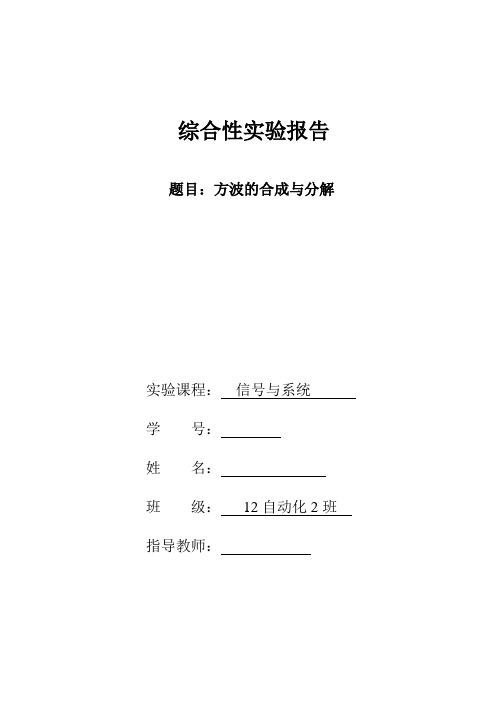
综合性实验报告题目:方波的合成与分解实验课程:信号与系统学号:姓名:班级:12自动化2班指导教师:方波的分解与合成一、实验类型综合性实验二、实验目的和要求1.观察方波信号的分解。
2.用同时分析法观测方波信号的频谱,并与方波的傅利叶级数各项的频率与系数作比较。
3.掌握带通滤波器的有关特性测试方法。
4.观测基波和其谐波的合成。
三、实验条件实验仪器1.20M 双踪示波器一台。
2.信号与系统实验箱。
四、实验原理1. 信号的频谱与测量信号的时域特性和频域特性是对信号的两种不同的描述方式。
对于一个时域的周期信号)t (f ,只要满足狄利克莱(Dirichlet)条件,就可以将其展开成三角形式或指数形式的傅里叶级数。
例如,对于一个周期为T 的时域周期信号)t (f ,可以用三角形式的傅里叶级数求出它的各次分量,在区间)1,1(T t t +内表示为:)sin cos 1(0)(t n nb t n n n a a t f Ω+Ω∑∞=+=即将信号分解成直流分量及许多余弦分量和正弦分量,研究其频谱分布情况。
AA(c)图7-1 信号的时域特性和频域特性信号的时域特性与频域特性之间有着密切的内在联系,这种联系可以用图7-1来形象地表示。
其中图7-1(a)是信号在幅度--时间--频率三维座标系统中的图形;图7-1(b)是信号在幅度--时间座标系统中的图形即波形图;把周期信号分解得到的各次谐波分量按频率的高低排列,就可以得到频谱图。
反映各频率分量幅度的频谱称为振幅频谱。
图7-1(c)是信号在幅度--频率座标系统中的图形即振幅频谱图。
反映各分量相位的频谱称为相位频谱。
在本实验中只研究信号振幅频谱。
周期信号的振幅频谱有三个性质:离散性、谐波性、收敛性。
测量时利用了这些性质。
从振幅频谱图上,可以直观地看出各频率分量所占的比重。
测量方法有同时分析法和顺序分析法。
同时分析法的基本工作原理是利用多个滤波器,把它们的中心频率分别调到被测信号的各个频率分量上。
方波信号的分解与合成

方波信号的分解与合成方波信号是一种在电子技术中常见的信号类型,它被广泛应用于数字电路、通信系统和控制系统中。
方波信号被描述为周期性的,其波形为高电平和低电平两种状态的交替出现。
本文将介绍方波信号的分解与合成。
一、方波信号的分解方波信号可以看作是由多个正弦波信号组成的。
根据傅里叶级数定理,任何一个周期信号都可以表示成一系列正弦波的叠加。
因此,我们可以将方波信号分解成一系列正弦波信号的叠加。
具体来说,我们可以通过傅里叶级数公式将方波信号分解为无限个正弦波信号的叠加:f(t) = (4/π) * [sin(ωt) + (1/3)sin(3ωt) + (1/5)sin(5ωt) + ...]其中,ω是正弦波的角频率,由周期T计算得到:ω = 2π/T。
式中的系数表示了每个正弦波信号的幅值。
显然,随着正弦波频率的增加,其幅值逐渐减小,因此只需要保留前几项即可近似表示方波信号。
二、方波信号的合成与分解相反,我们也可以将多个正弦波信号合成成一个方波信号。
这可以通过将多个正弦波信号的叠加,利用傅里叶变换得到一个方波信号的过程实现。
具体来说,我们可以将多个正弦波信号的幅值和相位进行适当的调整,使它们的叠加形成一个方波信号。
这个过程可以通过傅里叶变换实现,傅里叶变换将多个正弦波信号的叠加转换为频域上的一个复杂函数,然后再通过反向变换回到时域上得到方波信号。
三、应用方波信号的分解和合成在许多领域中都有广泛的应用。
在数字电路中,方波信号可以用于实现各种逻辑门和计数器。
在通信系统中,方波信号可以用于数字调制和解调。
在控制系统中,方波信号可以用于实现各种控制算法和控制器。
总结:本文介绍了方波信号的分解和合成。
方波信号可以看作是由多个正弦波信号组成的,可以通过傅里叶级数定理进行分解。
同时,我们也可以将多个正弦波信号合成成一个方波信号,利用傅里叶变换实现。
方波信号在数字电路、通信系统和控制系统中有广泛的应用。
第五组--信号波形合成电路实验(2010年电子竞赛C题论文)2
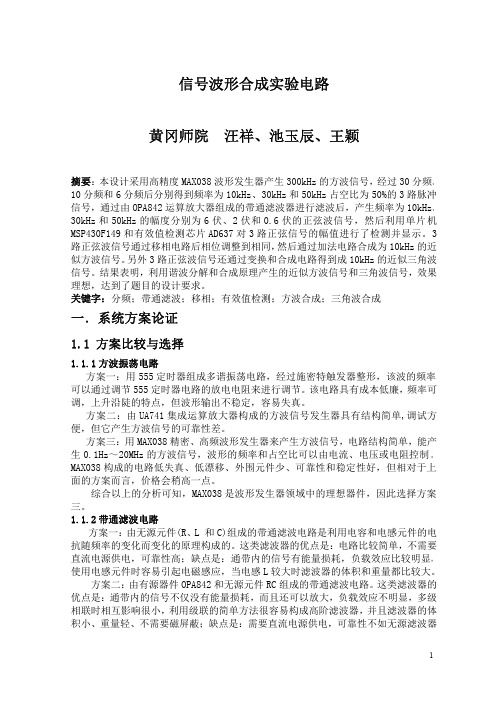
高,在高压、高频、大功率的场合不适用。 综合以上的分析,由 TI 公司生产的宽带低失真单位增益稳定的电压反馈运算放
大器 OPA842 组成的滤波电路满足本次设计的要求,因此选择方案二。 1.1.3 移相电路
方案一:用双极性运算放大器 OP07 组成的移相电路,由于 OP07 具有非常低的 输入失调电压,所以在很多应用场合不需要额外的调零措施。OP07 是一种低噪声, 非斩波稳零的双极性运算放大器,由它组成的移相电路具有电路简单、工作可靠、成 本低、波形好、适应性强,而且可以提供 180°的相移。
表一:信号编码表
A0
A1
X
1
0
0
1
0
波形 正弦波 方波 三角波
A0、A1 表示波形设定端;X 表示任意状态;1 为高电平;0 为低电平。 74LS14 非门对输出的信号进行整形,使输出的波形更加的理想。 3.1.2 分频电路 分频电路如附录图 3 所示,由 74LS90、74LS00、CD4013 三片芯片组成。先将 300KHz 的方波信号进行 3 分频、5 分频、15 分频,再通过 D 触发器二分频,最终得到 50KHz、 30KHz、10KHz 的正弦波信号。 74LS90 不仅可以用于计数,还能用于分频,一片 74LS90 可构成最大进制计数器 是十进制,若分频数大于 10,则要用两片或多片级联,级联后高位的周期即为分频 后的周期,但占空比并非 50%,这就需要用 D 触发器对分频后的方波进行整形。74LS00 是四集成与非门,在电路中起缓冲隔离的作用。CD4013 是由两个相同的、相互独立 的数据型触发器构成。每个触发器有独立的数据、置位、复位、时钟输入和 Q 及 Q
方案三:用 MAX038 精密、高频波形发生器来产生方波信号,电路结构简单,能产 生 0.1Hz~20MHz 的方波信号,波形的频率和占空比可以由电流、电压或电阻控制 。 MAX038 构成的电路低失真、低漂移、外围元件少、可靠性和稳定性好,但相对于上 面的方案而言,价格会稍高一点。
波形发生电路实验报告总结
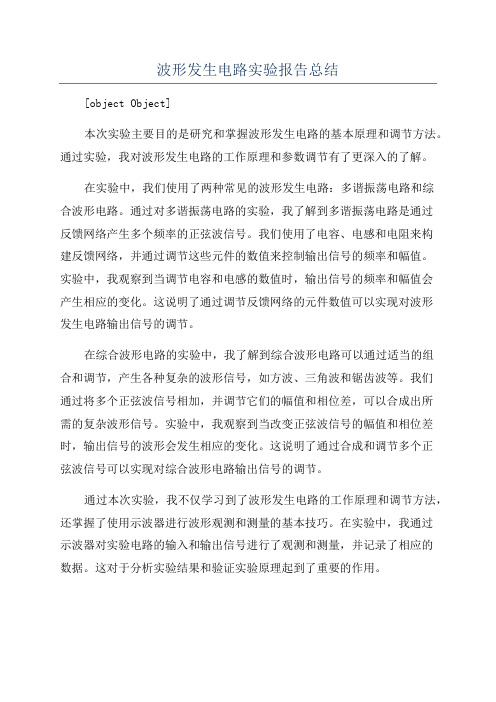
波形发生电路实验报告总结[object Object]本次实验主要目的是研究和掌握波形发生电路的基本原理和调节方法。
通过实验,我对波形发生电路的工作原理和参数调节有了更深入的了解。
在实验中,我们使用了两种常见的波形发生电路:多谐振荡电路和综合波形电路。
通过对多谐振荡电路的实验,我了解到多谐振荡电路是通过反馈网络产生多个频率的正弦波信号。
我们使用了电容、电感和电阻来构建反馈网络,并通过调节这些元件的数值来控制输出信号的频率和幅值。
实验中,我观察到当调节电容和电感的数值时,输出信号的频率和幅值会产生相应的变化。
这说明了通过调节反馈网络的元件数值可以实现对波形发生电路输出信号的调节。
在综合波形电路的实验中,我了解到综合波形电路可以通过适当的组合和调节,产生各种复杂的波形信号,如方波、三角波和锯齿波等。
我们通过将多个正弦波信号相加,并调节它们的幅值和相位差,可以合成出所需的复杂波形信号。
实验中,我观察到当改变正弦波信号的幅值和相位差时,输出信号的波形会发生相应的变化。
这说明了通过合成和调节多个正弦波信号可以实现对综合波形电路输出信号的调节。
通过本次实验,我不仅学习到了波形发生电路的工作原理和调节方法,还掌握了使用示波器进行波形观测和测量的基本技巧。
在实验中,我通过示波器对实验电路的输入和输出信号进行了观测和测量,并记录了相应的数据。
这对于分析实验结果和验证实验原理起到了重要的作用。
总体而言,本次实验使我对波形发生电路有了更深入的了解。
通过实验,我熟悉了波形发生电路的工作原理和调节方法,并学会了使用示波器进行波形观测和测量。
这对于我今后的学习和研究工作都具有重要的意义。
方波信号的分解与合成实验报告
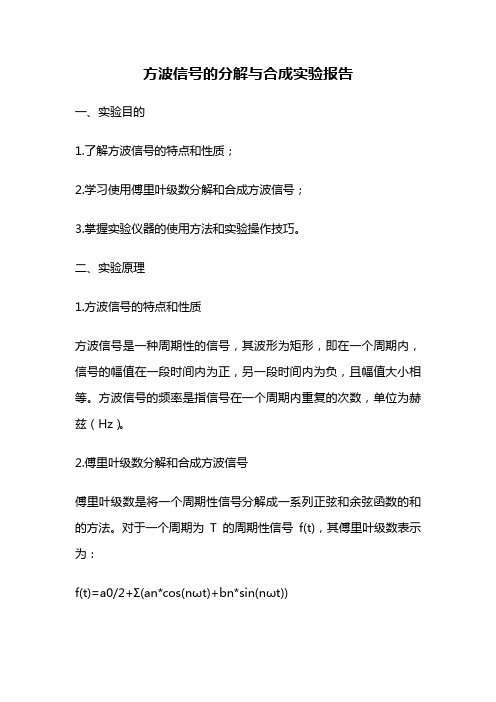
方波信号的分解与合成实验报告一、实验目的1.了解方波信号的特点和性质;2.学习使用傅里叶级数分解和合成方波信号;3.掌握实验仪器的使用方法和实验操作技巧。
二、实验原理1.方波信号的特点和性质方波信号是一种周期性的信号,其波形为矩形,即在一个周期内,信号的幅值在一段时间内为正,另一段时间内为负,且幅值大小相等。
方波信号的频率是指信号在一个周期内重复的次数,单位为赫兹(Hz)。
2.傅里叶级数分解和合成方波信号傅里叶级数是将一个周期性信号分解成一系列正弦和余弦函数的和的方法。
对于一个周期为T的周期性信号f(t),其傅里叶级数表示为:f(t)=a0/2+Σ(an*cos(nωt)+bn*sin(nωt))其中,a0/2为信号的直流分量,an和bn为信号的交流分量,ω=2π/T为信号的角频率,n为正整数。
傅里叶级数合成是将一系列正弦和余弦函数的和合成为一个周期性信号的方法。
对于一个周期为T的周期性信号f(t),其傅里叶级数合成表示为:f(t)=Σ(cncos(nωt)+dnsin(nωt))其中,cn和dn为信号的傅里叶系数,n为正整数。
三、实验器材和仪器1.示波器2.函数信号发生器3.万用表4.电阻箱5.电容箱四、实验步骤1.将函数信号发生器的输出设置为方波信号,频率为1kHz,幅值为5V。
2.将示波器的输入连接到函数信号发生器的输出端口。
3.调节示波器的水平和垂直控制,使得方波信号的波形清晰可见。
4.使用万用表测量方波信号的频率和幅值,并记录数据。
5.使用电阻箱和电容箱分别改变方波信号的频率和幅值,并记录数据。
6.使用傅里叶级数分解方法,将方波信号分解成一系列正弦和余弦函数的和,并记录数据。
7.使用傅里叶级数合成方法,将一系列正弦和余弦函数的和合成为一个周期性信号,并记录数据。
五、实验结果与分析1.方波信号的特点和性质通过示波器观察方波信号的波形,可以发现其具有矩形的特点,即在一个周期内,信号的幅值在一段时间内为正,另一段时间内为负,且幅值大小相等。
方波信号的分解与合成
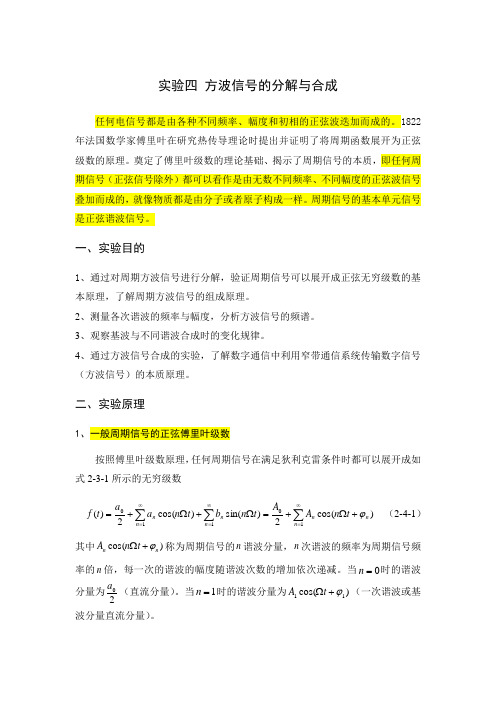
实验四 方波信号的分解与合成任何电信号都是由各种不同频率、幅度和初相的正弦波迭加而成的。
1822年法国数学家傅里叶在研究热传导理论时提出并证明了将周期函数展开为正弦级数的原理。
奠定了傅里叶级数的理论基础、揭示了周期信号的本质,即任何周期信号(正弦信号除外)都可以看作是由无数不同频率、不同幅度的正弦波信号叠加而成的,就像物质都是由分子或者原子构成一样。
周期信号的基本单元信号是正弦谐波信号。
一、实验目的1、通过对周期方波信号进行分解,验证周期信号可以展开成正弦无穷级数的基本原理,了解周期方波信号的组成原理。
2、测量各次谐波的频率与幅度,分析方波信号的频谱。
3、观察基波与不同谐波合成时的变化规律。
4、通过方波信号合成的实验,了解数字通信中利用窄带通信系统传输数字信号(方波信号)的本质原理。
二、实验原理1、一般周期信号的正弦傅里叶级数按照傅里叶级数原理,任何周期信号在满足狄利克雷条件时都可以展开成如式2-3-1所示的无穷级数∑∑∑∞=∞=∞=+Ω+=Ω+Ω+=10110)cos(2)sin()cos(2)(n n n n n n n t n A A t n b t n a a t f ϕ (2-4-1)其中)cos(n n t n A ϕ+Ω称为周期信号的n 谐波分量,n 次谐波的频率为周期信号频率的n 倍,每一次的谐波的幅度随谐波次数的增加依次递减。
当0=n 时的谐波分量为2a (直流分量)。
当1=n 时的谐波分量为)cos(11ϕ+Ωt A (一次谐波或基波分量直流分量)。
2、一般周期信号的有限次谐波合成及其方均误差按照傅里叶级数的基本原理可知,周期信号的无穷级数展开中,各次谐波的频率按照基波信号的频率的整数倍依次递增,幅度值随谐波次数的增加依次递减,趋近于零。
因此,从信号能量分布的角度来讲,周期信号的能量主要分布在频率较低的有限次谐波分量上。
此原理在通信技术当中得到广泛应用,是通信技术的理论基础。
信号波形合成

课程设计报告设计课题:信号波形合成实验专业班级:学生姓名:指导教师:设计时间:目录一、课程设计目的 (1)二、课程设计题目描述和要求 (1)1.基本要求 (1)2.发挥部分 (2)三、系统分析与设计 (2)1、方案设计 (2)方波振荡部分 (2)分频部分 (2)滤波部分 (2)移相、放大部分 (3)波形合成部分 (3)2、硬件实现 (3)方波振荡器 (3)分频器 (4)滤波器 (5)移向、放大器 (5)波形合成器 (6)四、系统调试过程中出现的主要问题 (7)五、系统运行报告与结论 (7)六、总结 (9)七、参考书目 (9)八、附录 (10)信号波形合成实验一、课程设计目的设计制作一个电路,能够产生多个不同频率的正弦信号,并将这些信号再合成为近似方波和其他信号。
电路示意图如图1所示:图1 电路示意图二、课程设计题目描述和要求1.基本要求(1)方波振荡器的信号经分频与滤波处理,同时产生频率为10kHz和30kHz 的正弦波信号,这两种信号应具有确定的相位关系;(2)产生的信号波形无明显失真,幅度峰峰值分别为6V和2V;(3)制作一个由移相器和加法器构成的信号合成电路,将产生的10kHz和30kHz正弦波信号,作为基波和3次谐波,合成一个近似方波,波形幅度为5V,合成波形的形状如图2所示。
图2 利用基波和3次谐波合成的近似方波2.发挥部分(1)再产生50kHz的正弦信号作为5次谐波,参与信号合成,使合成的波形更接近于方波;(2)根据三角波谐波的组成关系,设计一个新的信号合成电路,将产生的10kHz、30kHz等各个正弦信号,合成一个近似的三角波形;(3)其他。
三、系统分析与设计1、方案设计方波振荡部分方波振荡电路采用555定时器组成多谐振荡器,调节至300kHz 左右方波,由于之后的分频电路具有调节占空比功能,所以方波产生电路暂时不需要调节占空比。
分频部分分频部分实现将产生的方波通过分频产生10kHz 、30kHz 和50kHz 的新的方波。
实验二-方波信号的分解与合成及相位、幅度对波形合成的影响
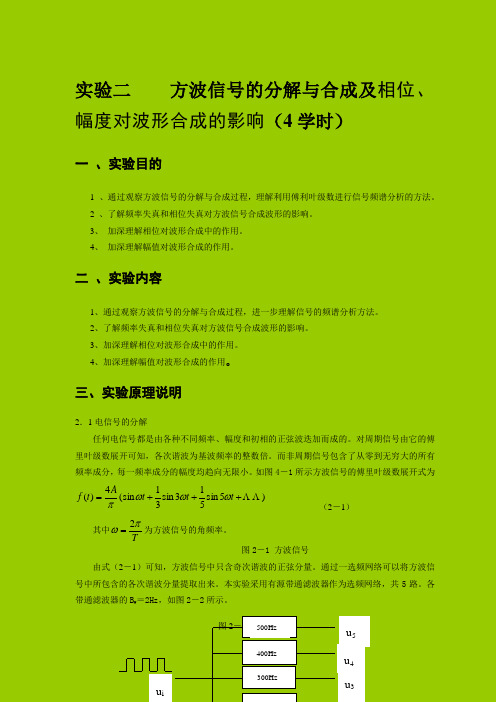
实验二 方波信号的分解与合成及相位、幅度对波形合成的影响(4学时)一 、实验目的1 、通过观察方波信号的分解与合成过程,理解利用傅利叶级数进行信号频谱分析的方法。
2 、了解频率失真和相位失真对方波信号合成波形的影响。
3、 加深理解相位对波形合成中的作用。
4、 加深理解幅值对波形合成的作用。
二 、实验内容1、通过观察方波信号的分解与合成过程,进一步理解信号的频谱分析方法。
2、了解频率失真和相位失真对方波信号合成波形的影响。
3、加深理解相位对波形合成中的作用。
4、加深理解幅值对波形合成的作用。
三、实验原理说明2.1电信号的分解任何电信号都是由各种不同频率、幅度和初相的正弦波迭加而成的。
对周期信号由它的傅里叶级数展开可知,各次谐波为基波频率的整数倍。
而非周期信号包含了从零到无穷大的所有频率成分,每一频率成分的幅度均趋向无限小。
如图4-1所示方波信号的傅里叶级数展开式为 )5sin 513sin 31(sin 4)( +++=t t t A t f ωωωπ (2-1) 其中Tπω2=为方波信号的角频率。
图2-1 方波信号由式(2-1)可知,方波信号中只含奇次谐波的正弦分量。
通过一选频网络可以将方波信号中所包含的各次谐波分量提取出来。
本实验采用有源带通滤波器作为选频网络,共5路。
各带通滤波器的B W =2Hz ,如图2-2所示。
图2-2带通滤波器 u iu 5u 4 u 3 300Hz 400Hz500Hz将被测信号加到选频网络上,从每一带通滤波器的输出端可以用示波器观察到相应频率的谐波分量。
本实验采用的被测信号为100Hz 的方波,通过各滤波器后,可观察到1、3、5次谐波,如图2-3。
而2、4次谐波在理想情况下应该无输出信号,但实际上方波可能有少量失真以及受滤波器本身滤波特性的限制而使偶次谐波分量未能达到理想的情况。
方波激励方波基波方波三次谐波方波五次谐波图2-3 方波的1、2、3次谐波实验电路图2.2.1电路框图图2-4电路框图 由双运放LM324组成带通滤波电路(B W 约2Hz )和射随器;三极管9013组成移相电路,起到相位补偿的作用。
方波振荡电路设计
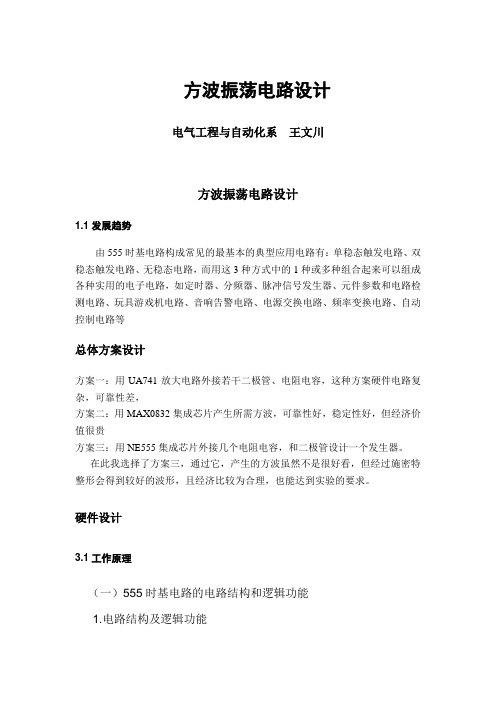
方波振荡电路设计电气工程与自动化系王文川方波振荡电路设计1.1发展趋势由555时基电路构成常见的最基本的典型应用电路有:单稳态触发电路、双稳态触发电路、无稳态电路,而用这3种方式中的1种或多种组合起来可以组成各种实用的电子电路,如定时器、分频器、脉冲信号发生器、元件参数和电路检测电路、玩具游戏机电路、音响告警电路、电源交换电路、频率变换电路、自动控制电路等总体方案设计方案一:用UA741放大电路外接若干二极管、电阻电容,这种方案硬件电路复杂,可靠性差,方案二:用MAX0832集成芯片产生所需方波,可靠性好,稳定性好,但经济价值很贵方案三:用NE555集成芯片外接几个电阻电容,和二极管设计一个发生器。
在此我选择了方案三,通过它,产生的方波虽然不是很好看,但经过施密特整形会得到较好的波形,且经济比较为合理,也能达到实验的要求。
硬件设计3.1工作原理(一)555时基电路的电路结构和逻辑功能1.电路结构及逻辑功能图1为555时基电路的电路结构和8脚双列直插式的引脚图,由图可知555电路由电阻分压器、电压比较器、基本RS触发器、放电管和输出缓冲器5个部分组成。
它的各个引脚功能如下:1脚:GND(或Vss)外接电源负端VSS或接地,一般情况下接地。
8脚:VCC(或VDD)外接电源VCC,双极型时基电路VCC的范围是4.5~16V,CMOS型时基电路VCC的范围为3~18V。
一般情况下选用5V。
3脚:OUT(或Vo)输出端。
2脚:TR低触发端。
6脚:TH高触发端。
4脚:R是直接清零端。
当R端接低电平,则时基电路不工作,此时不论TR、TH处于何电平,时基电路输出为“0”,该端不用时应接高电平。
5脚:CO(或VC)为控制电压端。
若此端外接电压,则可改变内部两个比较器的基准电压,当该端不用时,应将该端串入一只0.01μF电容接地,以防引入干扰。
7脚:D放电端。
该端与放电管集电极相连,用做定时器时电容的放电。
电阻分压器由三个5kΩ的等值电阻串联而成。
如何进行电路的信号合成和分析

如何进行电路的信号合成和分析在电子技术领域,信号合成和分析是非常重要的技术。
通过合成不同的信号,我们可以实现电路的各种功能;而通过分析信号,我们可以了解电路的性能以及可能存在的问题。
本文将介绍如何进行电路的信号合成和分析。
一、信号合成信号合成是将不同的信号组合成一个完整的信号的过程。
通过合成不同频率、振幅和相位等参数的信号,我们可以实现各种电路的功能。
以下是一些常用的信号合成方法:1. 正弦波合成:正弦波是一种基本的周期信号,可以通过变换其频率、振幅和相位来合成不同的信号。
在电子电路中,正弦波合成常用于产生音频信号、交流电源等。
2. 方波合成:方波是一种具有等占空比的脉冲信号。
通过调节脉冲宽度和频率,可以合成各种需要的方波信号,如脉冲宽度调制(PWM)信号。
3. 脉冲合成:脉冲信号可以通过调节脉冲宽度、频率和幅值来合成。
脉冲信号广泛应用于数字电路、通信系统等领域。
4. 合波器合成:合波器可以将多个输入信号进行线性加权合成,输出为一个信号。
这种合成方法广泛应用于混音器、音频处理等领域。
二、信号分析信号分析是对电路中的信号进行分析和评估,以了解电路的性能和可能存在的问题。
以下是一些常用的信号分析方法:1. 频谱分析:频谱分析是对信号的频率成分进行分析的方法。
通过使用频谱仪或傅里叶变换等工具,可以将信号分解为不同频率的分量,了解信号的频率特性。
2. 时域分析:时域分析是对信号的时间变化进行分析的方法。
常用的时域分析工具包括示波器和数字存储示波器,通过观察信号在时间上的波形变化,可以了解信号的幅度、频率和相位等特性。
3. 调制分析:调制分析是对调制信号及其载波信号进行分析的方法。
通过分析调制信号的频谱和幅度调制比等参数,可以了解调制信号的调制程度以及可能存在的失真问题。
4. 频率响应分析:频率响应分析是对电路的频率特性进行分析的方法。
通过输入不同频率的信号,并测量输出信号的幅度和相位等参数,可以绘制出电路的频率响应曲线,了解电路的放大或衰减特性。
方波信号合成与分解

方波信号合成与分解一、方波信号的定义与特点方波信号是一种周期性的非正弦波形信号,其波形为由高电平和低电平构成的矩形脉冲,具有以下特点:1. 周期性:方波信号是一种周期性信号,其周期为T,即高电平和低电平的时间之和。
2. 对称性:在一个周期内,方波信号的高电平和低电平时间相等,即具有对称性。
3. 傅里叶级数展开:根据傅里叶级数展开定理,任意一个周期为T的方波信号都可以表示为正弦函数的无穷级数。
二、方波信号合成1. 正弦函数合成法根据傅里叶级数展开定理,任意一个周期为T的方波信号都可以表示为正弦函数的无穷级数。
具体地说,在一个周期内,将矩形脉冲拆分成若干个相同宽度的小矩形脉冲,并将每个小矩形脉冲看作一个单位阶跃函数。
然后将单位阶跃函数用正弦函数展开,并将所有正弦函数加起来即可得到原始方波信号。
2. 方波滤波器法方波滤波器是一种特殊的电路,可以将正弦波转换成方波信号。
具体地说,方波滤波器由一个RC电路和一个比较器组成。
当输入正弦波信号经过RC电路后,输出的信号会变成一个带有衰减的矩形脉冲。
然后将这个带有衰减的矩形脉冲输入比较器中进行比较,即可得到原始方波信号。
三、方波信号分解1. 正弦函数分解法根据傅里叶级数展开定理,任意一个周期为T的方波信号都可以表示为正弦函数的无穷级数。
因此,可以将原始方波信号分解成若干个正弦函数之和。
具体地说,在一个周期内,将矩形脉冲拆分成若干个相同宽度的小矩形脉冲,并将每个小矩形脉冲看作一个单位阶跃函数。
然后将单位阶跃函数用正弦函数展开,并逐一提取每个正弦函数的系数即可得到原始方波信号的正弦函数分解式。
2. 小波变换法小波变换是一种新型的时频分析方法,可以对信号进行局部分析。
具体地说,可以将原始方波信号进行小波变换,得到一系列小波系数。
然后根据小波系数的大小和位置,可以将原始方波信号分解成若干个不同频率和不同时间范围的小波分量。
四、方波信号应用1. 通讯系统在数字通讯系统中,方波信号常用于表示数字信息。
方波发生电路实验报告
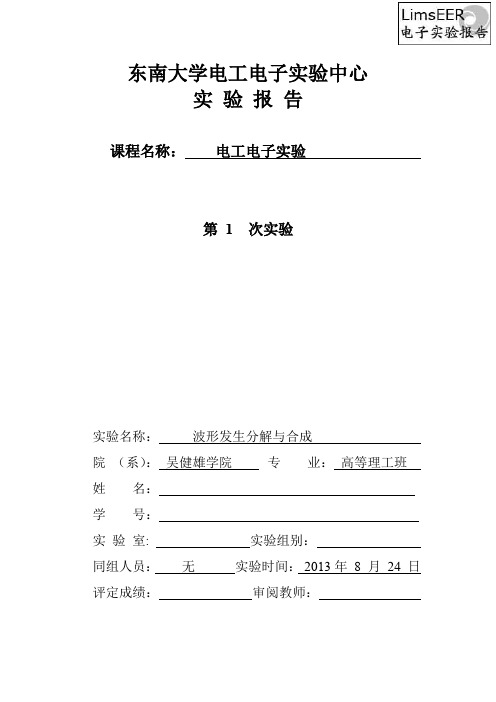
东南大学电工电子实验中心实验报告课程名称:电工电子实验第1次实验实验名称:波形发生分解与合成院(系):吴健雄学院专业:高等理工班姓名:学号:实验室: 实验组别:同组人员:无实验时间:2013年8月24日评定成绩:审阅教师:一、实验内容要求基本要求:1.设计一个方波发生器,要求其频率为1kHz,幅度为5V;2.设计合适的滤波器,从方波中提取出基波和3次谐波;3.设计一个加法器电路,将基波和3次谐波信号按一定规律相加,将合成后的信号与原始信号比较,分析它们的区别及原因。
提高要求:⏹设计5次谐波滤波器及移相电路,调整各次谐波的幅度和相位,将合成后的信号与原始信号比较,并与基本要求部分作对比,分析它们的区别及原因。
创新要求:⏹用类似方式合成其他周期信号,如三角波、锯齿波等二、实验内容要求1.方波发生器图1:方波发生电路图1中的方波发生电路,利用迟滞比较器基础上,把输出电压经电阻电容反馈到集成运放的反相端,然后在运放的输出端使用两个稳压管组成的双向限幅电路,得到较理想的1kHz方波。
2.滤波器设计滤波器主要使用软件FilerPro,采用贝塞尔三级滤波结构,提取基波、三次谐波、五次谐波的设计电路如图2,图3,图4所示。
图2:提取基波的滤波器设计图3:提取3次谐波的滤波器设计图4:提取5次谐波的滤波器设计3. 移项电路设计按照要求应该是将分离的基波、三次谐波和五次谐波用加法器相加,但是由于在滤波的过程中对原来的波形可能会有相位的偏差,因此在相加之前需要对他们进行移项。
移项电路有以下两种选择。
图5:3311out in U j CR U j CR ωω-=+图6:3311out in U j CR U j CR ωω-+=+ 通过调节电路的参数可以进行相位的具体调节。
4. 加法电路设计在通过移项电路将各个波形相位调节一致之后,通过简单的反相加法器就能得到最后的合成信号图7:反相加法器三、模拟电路调试a)方波发生器模拟得到的方波幅值较低,我们计划在具体搭试时加一级放大器,将其放大至设计要求的5V。
方波电路的工作原理

方波电路的工作原理
方波电路是一种能够产生方波信号的电路。
它由一个控制开关、一个电容和一个电感组成。
工作原理如下:当控制开关关闭时,电容开始通过电流进行充电。
在这个过程中,电容内的电压将逐渐上升。
当电容内的电压达到一定阈值时,控制开关将会打开,此时电容开始通过电感进行放电。
当电容放电时,其内的电压开始下降。
在电容放电的过程中,电感将对流过的电流产生电压反向的作用。
这将导致电容的电压开始下降,直到达到另一个阈值,控制开关再次关闭。
这个过程将不断重复,从而产生连续的方波信号。
方波信号的周期和占空比可以通过调整电容和电感的数值来控制。
方波的合成与分解
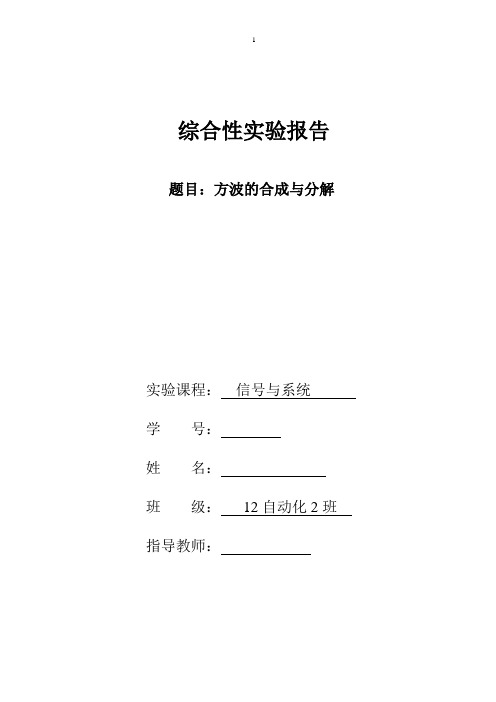
1综合性实验报告题目:方波的合成与分解实验课程:信号与系统学号:姓名:班级:12自动化2班指导教师:方波的分解与合成一、实验类型综合性实验二、实验目的和要求1.观察方波信号的分解。
2.用同时分析法观测方波信号的频谱,并与方波的傅利叶级数各项的频率与系数作比较。
3.掌握带通滤波器的有关特性测试方法。
4.观测基波和其谐波的合成。
三、实验条件实验仪器1.20M 双踪示波器一台。
2.信号与系统实验箱。
四、实验原理1. 信号的频谱与测量信号的时域特性和频域特性是对信号的两种不同的描述方式。
对于一个时域的周期信号)t (f ,只要满足狄利克莱(Dirichlet)条件,就可以将其展开成三角形式或指数形式的傅里叶级数。
例如,对于一个周期为T 的时域周期信号)t (f ,可以用三角形式的傅里叶级数求出它的各次分量,在区间)1,1(T t t +内表示为:)sin cos 1(0)(t n nb t n n n a a t f Ω+Ω∑∞=+=即将信号分解成直流分量及许多余弦分量和正弦分量,研究其频谱分布情况。
AA(c)图7-1 信号的时域特性和频域特性信号的时域特性与频域特性之间有着密切的内在联系,这种联系可以用图7-1来形象地表示。
其中图7-1(a)是信号在幅度--时间--频率三维座标系统中的图形;图7-1(b)是信号在幅度--时间座标系统中的图形即波形图;把周期信号分解得到的各次谐波分量按频率的高低排列,就可以得到频谱图。
反映各频率分量幅度的频谱称为振幅频谱。
图7-1(c)是信号在幅度--频率座标系统中的图形即振幅频谱图。
反映各分量相位的频谱称为相位频谱。
在本实验中只研究信号振幅频谱。
周期信号的振幅频谱有三个性质:离散性、谐波性、收敛性。
测量时利用了这些性质。
从振幅频谱图上,可以直观地看出各频率分量所占的比重。
测量方法有同时分析法和顺序分析法。
同时分析法的基本工作原理是利用多个滤波器,把它们的中心频率分别调到被测信号的各个频率分量上。
信号波形合成实验电路
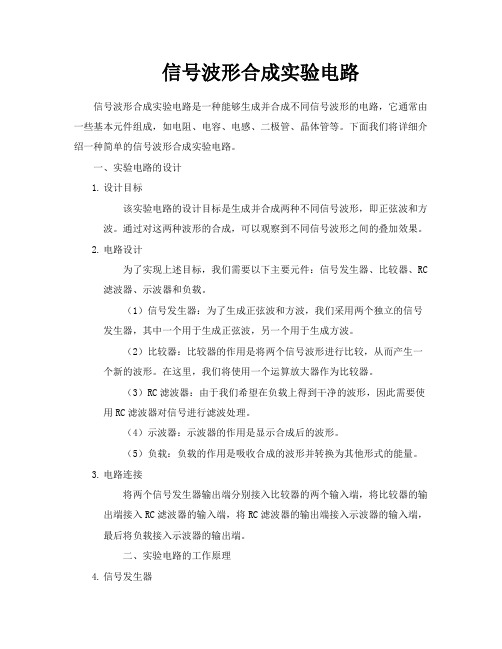
信号波形合成实验电路信号波形合成实验电路是一种能够生成并合成不同信号波形的电路,它通常由一些基本元件组成,如电阻、电容、电感、二极管、晶体管等。
下面我们将详细介绍一种简单的信号波形合成实验电路。
一、实验电路的设计1.设计目标该实验电路的设计目标是生成并合成两种不同信号波形,即正弦波和方波。
通过对这两种波形的合成,可以观察到不同信号波形之间的叠加效果。
2.电路设计为了实现上述目标,我们需要以下主要元件:信号发生器、比较器、RC 滤波器、示波器和负载。
(1)信号发生器:为了生成正弦波和方波,我们采用两个独立的信号发生器,其中一个用于生成正弦波,另一个用于生成方波。
(2)比较器:比较器的作用是将两个信号波形进行比较,从而产生一个新的波形。
在这里,我们将使用一个运算放大器作为比较器。
(3)RC滤波器:由于我们希望在负载上得到干净的波形,因此需要使用RC滤波器对信号进行滤波处理。
(4)示波器:示波器的作用是显示合成后的波形。
(5)负载:负载的作用是吸收合成的波形并转换为其他形式的能量。
3.电路连接将两个信号发生器输出端分别接入比较器的两个输入端,将比较器的输出端接入RC滤波器的输入端,将RC滤波器的输出端接入示波器的输入端,最后将负载接入示波器的输出端。
二、实验电路的工作原理4.信号发生器信号发生器是一种能够产生不同波形(如正弦波、方波等)的电路。
在这里,我们采用两个独立的信号发生器,一个用于生成正弦波,另一个用于生成方波。
5.比较器比较器的作用是比较两个信号波形,产生一个新的波形。
在这里,我们将使用一个运算放大器作为比较器,将两个信号波形进行比较,从而产生一个新的波形。
6.RC滤波器RC滤波器是一种常见的滤波器,它由电阻和电容组成。
在这里,我们使用RC滤波器对信号进行滤波处理,从而在负载上得到干净的波形。
7.示波器示波器是一种用来显示波形的电子仪器。
在这里,我们将示波器的输入端接入合成后的波形,以便观察和记录合成后的波形。
信号波形合成实验电路设计
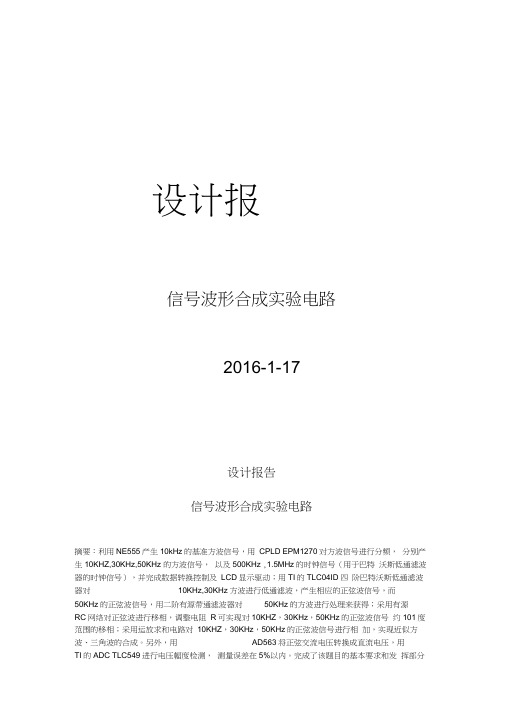
设计报信号波形合成实验电路2016-1-17设计报告信号波形合成实验电路摘要:利用NE555产生10kHz的基准方波信号,用CPLD EPM1270对方波信号进行分频,分别产生10KHZ,30KHz,50KHz 的方波信号,以及500KHz ,1.5MHz的时钟信号(用于巴特沃斯低通滤波器的时钟信号),并完成数据转换控制及LCD显示驱动;用TI的TLC04ID四阶巴特沃斯低通滤波器对10KHz,30KHz方波进行低通滤波,产生相应的正弦波信号,而50KHz的正弦波信号,用二阶有源带通滤波器对50KHz的方波进行处理来获得;采用有源RC网络对正弦波进行移相,调整电阻R可实现对10KHZ,30KHz,50KHz的正弦波信号约101度范围的移相;采用运放求和电路对10KHZ,30KHz,50KHz的正弦波信号进行相加,实现近似方波、三角波的合成。
另外,用AD563将正弦交流电压转换成直流电压,用TI的ADC TLC549进行电压幅度检测,测量误差在5%以内。
完成了该题目的基本要求和发挥部分的全部内容。
共用TI公司五种IC。
关键词:波形合成滤波器移相网络电压测量一、系统方案论证根据题目要求,设计制作一个电路,将产生的频率为6MHz方波信号,经分频滤波后得到10KHz、30KHz、50KHz频率的正弦信号,然后将这些信号再合成为近似方波信号和近似三角波信号,并制作数字显示电表,检测并显示各正弦波信号的幅值。
1. 方波振荡器方案比较方案1: 555电路产生方波信号方案2:运放电路产生方波信号方案3:用门电路及石英晶体产生方波信号。
其中,方案1、2所产生的方波信号频率不高,频率稳定性较差,而方案3产生的方波信号频率稳定度高,也可产生较高频率(MHz以上)信号,故采用方案3产生方波信号。
2. 分频电路方案比较方案1:采用选频电路提取方波的谐波信号,分别得到基波、三次谐波和五次谐波频率信号。
缺点:对选频电路的指标要求高,电路不易实现,得到的谐波信号也不稳定。
方波叠加模拟信号 电路
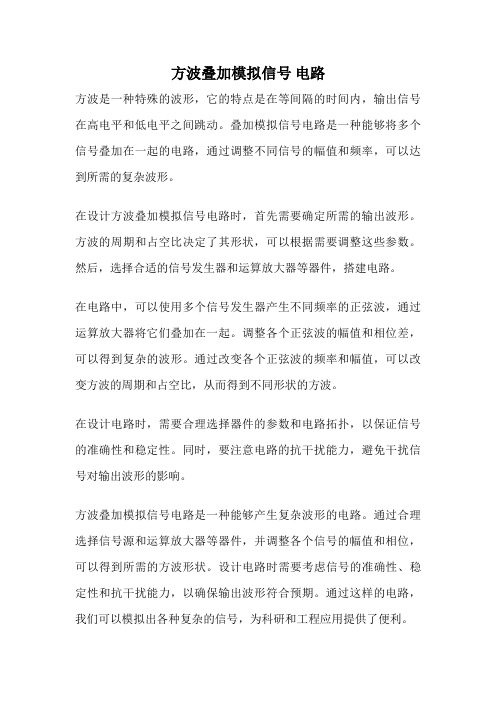
方波叠加模拟信号电路
方波是一种特殊的波形,它的特点是在等间隔的时间内,输出信号在高电平和低电平之间跳动。
叠加模拟信号电路是一种能够将多个信号叠加在一起的电路,通过调整不同信号的幅值和频率,可以达到所需的复杂波形。
在设计方波叠加模拟信号电路时,首先需要确定所需的输出波形。
方波的周期和占空比决定了其形状,可以根据需要调整这些参数。
然后,选择合适的信号发生器和运算放大器等器件,搭建电路。
在电路中,可以使用多个信号发生器产生不同频率的正弦波,通过运算放大器将它们叠加在一起。
调整各个正弦波的幅值和相位差,可以得到复杂的波形。
通过改变各个正弦波的频率和幅值,可以改变方波的周期和占空比,从而得到不同形状的方波。
在设计电路时,需要合理选择器件的参数和电路拓扑,以保证信号的准确性和稳定性。
同时,要注意电路的抗干扰能力,避免干扰信号对输出波形的影响。
方波叠加模拟信号电路是一种能够产生复杂波形的电路。
通过合理选择信号源和运算放大器等器件,并调整各个信号的幅值和相位,可以得到所需的方波形状。
设计电路时需要考虑信号的准确性、稳定性和抗干扰能力,以确保输出波形符合预期。
通过这样的电路,我们可以模拟出各种复杂的信号,为科研和工程应用提供了便利。
- 1、下载文档前请自行甄别文档内容的完整性,平台不提供额外的编辑、内容补充、找答案等附加服务。
- 2、"仅部分预览"的文档,不可在线预览部分如存在完整性等问题,可反馈申请退款(可完整预览的文档不适用该条件!)。
- 3、如文档侵犯您的权益,请联系客服反馈,我们会尽快为您处理(人工客服工作时间:9:00-18:30)。
毕业设计(论文)
方波信号波形合成电路
专业年级 2007电子信息工程
学号 ********
姓名周兴平
指导教师张秀平
评阅人
2011年6月
中国常州
河海大学
本科毕业设计(论文)任务书
(理工科类)
Ⅰ、毕业设计(论文)题目:
方波信号波形合成电路
Ⅱ、毕业设计(论文)工作内容(从综合运用知识、研究方案的设计、研究方法和手段的运用、应用文献资料、数据分析处理、图纸质量、技术或观点创新等方面详细说明):设计制作一个电路,能够产生多个不同频率的正弦信号,并将这些信号再合成为近似方波。
电路示意图如图所示。
基本要求:1、方波振荡器的信号经分频与滤波处理,同时产生频率为10kHz和30kHz的正弦波信号,这2种信号应具有确定的相位关系;
2、产生的信号波形无明显失真,幅度峰峰值分别为6V和2V;
3、制作一个由移相器和加法器构成的信号合成电路,将产生的10kHz和30kHz 的正弦波信号作为基波和3次谐波,合成一个近似方波,波形幅度为5V。
4、再产生50KHz的正弦信号作为5次谐波,参与信号合成,使合成的波形更接近于方波;
5、设计制作一个能对各个正弦信号的幅度进行测量和数字显示的电路,测量误差不大于正负5%。
6、总结毕业设计内容,撰写毕业设计论文。
Ⅲ、进度安排:
第一阶段(10年下13周——15周):搜集相关资料,复习掌握相关的理论知识。
第二阶段(16周——20周):方波产生电路设计、调试。
第三阶段(11年上1周——8周):谐波产生电路设计、调试,方波合成。
第四阶段(9周——13周):正弦波幅度测量和显示电路设计。
第五阶段(14周——):撰写毕业设计论文,答辩。
Ⅳ、主要参考资料:
[1]、郑君里等《信号与系统》(上)[M].高等教育出版社,2005.
[2]、康华光.《电子技术基础》(模拟部分)[M].高等教育出版社,2003.
[3]、胡汉才.《单片机原理及系统设计》.清华大学出版社,2002.
[4]、.
指导教师:张秀平,2010 年11 月28 日学生姓名:周兴平,专业年级:07级电子信息工程系负责人审核意见(从选题是否符合专业培养目标、是否结合科研或工程实际、综合训练程度、内容难度及工作量等方面加以审核):
系负责人签字:,2010 年12 月8 日
摘要
课题任务是对一个特定频率的方波进行变换产生多个不同频率的弦信号,再将这些正弦信号合成为近似方波。
首先设计制作一个特定频率的方波发生器,并在这个方波上进行必要的信号转换,分别产生10KHz、30KHz 和50KHz 的正弦波,然后对这三个正弦波进行频率合成,合成后的目标信号为10KHz近似方波。
本课题的理论基础是傅里叶级数。
法国数学家傅里叶发现,任何周期函数都可以用正弦函数和余弦函数构成的无穷级数来表示(选择正弦函数与余弦函数作为基函数是因为它们是正交的),后世称为傅里叶级数一种特殊的三角级数。
假设{a0, a1, a2, a3, ..., an, ...}和{b1, b2, b3, ..., bn, ...}是一组无穷的常数。
这些常数被称为傅里叶系数。
x是一个变量。
普通的傅里叶级数可以表示为:
F(x) = a0/2 + a1 cos x + b1 sin x + a2 cos 2x + b2 sin 2x + ...+ an cos nx + bn sin nx + ...
一些波形比较简单,比如单纯的正弦波,但是这些只是理论上的。
在实际生活中,大多数波形都包含谐波频率(最小频率或基波频率的倍数)的能量。
谐波频率能量相较于基波频率能量的比例是依赖于波形的。
傅里叶级数将这种波形数学的定义为相对于时间的位移函数(通常为振幅、频率或相位)。
[1]
随着傅里叶级数中计算的项的增加,级数会越来越近似于定义复杂信号波形的精确函数。
计算机能够计算出傅里叶级数的成百上千甚至数百万个项。
本课题就是基于此原理,取基波、三次谐波及五次谐波进行合成。
当然谐波之间要满足一定相位及幅值比例关系,所以用同一振荡器产生信号,再进行分频及移相等处理。
关键词:方波振荡器;傅里叶级数;分频;滤波;移相电路
Abstract
Mission is to issue a specific frequency square wave to transform strings produce multiple signals of different frequencies, then the synthesis of these sine square wave signal. First, to design a specific frequency square wave generator, and in this square wave signal on the need for conversion, were generated 10KHz, 30KHz and 50KHz sine wave, then a frequency of the three sine wave synthesis, synthesis of the target after 10KHz square wave signal.
The project is based on Fourier series theory. French mathematician Fourier discovered that any periodic function can be used sine and cosine functions to represent the infinite series form (select the sine function and cosine function as basis functions because they are orthogonal), later known as the Fourier A special series of triangular series. Suppose {a0, a1, a2, a3, ..., an, ...} and {b1, b2, b3, ..., bn, ...} is a set of infinite constant. These constants are called Fourier coefficients. x is a variable. Ordinary Fourier series can be expressed as:
F(x) = a0/2 + a1 cos x + b1 sin x + a2 cos 2x + b2 sin 2x + ...+ an cos nx + bn sin nx + ...
Some relatively simple waveforms, such as pure sine wave, but these are only theoretical. In real life, most of the waveforms contain harmonic frequency (minimum frequency or a multiple of the fundamental frequency) energy. Harmonic frequency energy compared to the ratio of the fundamental frequency energy is dependent on the waveform. Fourier series mathematical definition of this kind of waveform relative to the displacement function of time (usually amplitude, frequency or phase).
Calculated as the Fourier series of items increasing, the series will be more similar to the definition of the precise function of complex signal waveforms. Computer can calculate the Fourier series of hundreds of thousands or even millions of entries.
This topic is based on this principle, take fundamental, third harmonic and fifth harmonic synthesis. Of course, between the harmonic phase and amplitude to meet certain proportional relationship, so with the same oscillator signal, then the frequency and the shift is equal treatment.
Keywords: Square wave oscillator; Fourier series; frequency; filter; phase-shifting circuit。
